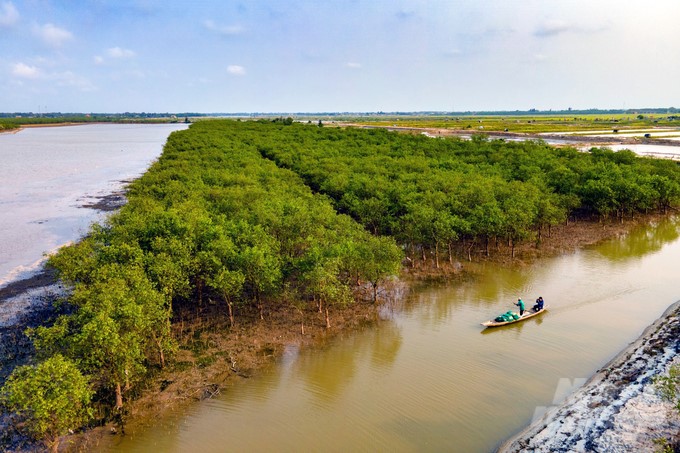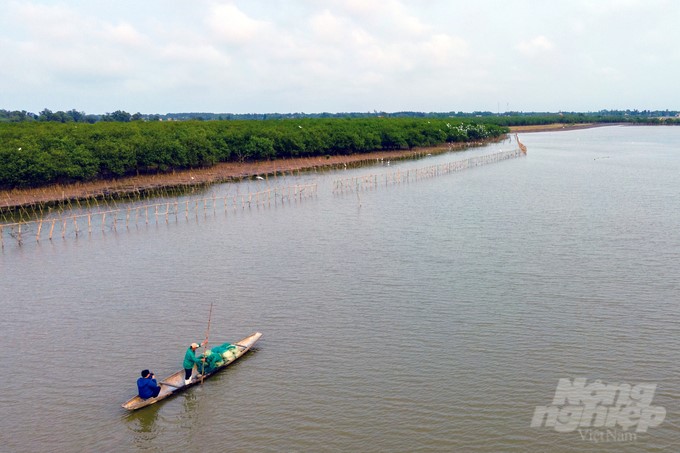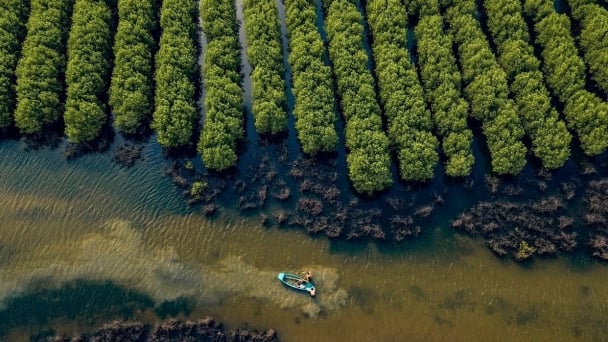June 16, 2025 | 11:34 GMT +7
June 16, 2025 | 11:34 GMT +7
Hotline: 0913.378.918
June 16, 2025 | 11:34 GMT +7
Hotline: 0913.378.918

Mangroves become "treasures" for the people of Bac Phuoc Island. Photo: Vo Dung.
Taking us to see the results of the dyke and mangrove forest protection work, Mr. Truong Xuan Luat, Head of Bac Phuoc village, shared with full excitement: "After the dyke and mangrove apple forest were established, there have been many changes in the people's lives".
Now in every rainy season, the people here are less worried about landslides. They no longer have to run away from storms and floods, or struggling to make end met. This land’s children no longer go away from home to make a living around the country.
Over the years, the mangrove apple forest, which has become more and more solid as a green wall, along with the dyke surrounding the villages, has blocked the water waves to help people feel secured while living their lives and performing aquaculture and agricultural production.
"Having realized the great value of the mangrove forest and dyke line, the people of Bac Phuoc Island have tried to protect and preserve them for many years. Bac Phuoc Island is home to many species of seafood and wild birds and has become a sustainable livelihood for many households in the area. Preserving the mangrove apple forest and protecting the dyke line means protecing the next generations," said Mr. Truong Xuan Luat.
Previously, people living on Bac Phuoc Island faced many difficulties because of the harsh and unusual weather. Located at the gateway to the sea on the Thach Han River, in every season of storms, floods, and high tides, many dikes surrounding residential and production areas built by people are eroded. As a result, a large part of the crop area was washed away. The land was flooded with salt, making it unable to cultivate, and people's lives were thus surrounded by poverty.
"That is the constant concern of the Party Committee, the government, and the people of Trieu Phuoc commune. No one wishes to leave their birthplace. But thanks to the mangrove apple forest, many households’ livelihoods are guaranteed. The environment becomes green, clean, and beautiful. Those positive changes make many people love their homeland even more," said Mr. Nguyen Van Vui, Chairman of the Trieu Phuoc Commune People's Committee.
The year 2006 marked the great change in this land. A 7.6-km-long dyke surrounding the village was constructed at a cost of tens of billions of dongs. In order to protect the dyke, with the support of the Central Government’s National Target Program on dyke upgrading and protection, a mangrove apple forest was also planted and taken care of.
The mangrove apple forest grew thanks to the protection efforts of the people and local authorities. This forest model blocked the waves and wind, protected villages and people, attracted many seafood species to sellte down in the area. The mangrove apple forest created landscapes, improved the ecological environment for the region, and contributed to preserving biodiversity.

Thanks to mangroves and breakwaters, the people's lives on Bac Phuong Island have become less destitute. Photo: Vo Dung.
The people of Bac Phuoc Island now protect the dyke and mangrove apple forest like they are protecting the village's treasures. Bac Phuoc Island currently has more than 40 ha of mangroves, mostly mangrove apple trees that are growing well.
Living under the protection of the dyke and mangrove apple forest, the people's lives here have prospered. Agricultural production has gradually stabilized. People no longer have to struggle to bring food on the table. The source of seafood exploited from the mangroves has ensured the people’s livelihood.
Mr. Truong Xuan Luat said, "Bac Phuoc Island has now lost its 'poverty specialty'. Instead, thanks to the effectiveness of the dyke and mangrove apple forest, people's lives have gradually improved. In the future, Bac Phuoc Island can also become a place to organize experiential tourism and ecotourism activities. This will give this land’s people the opportunity to develop more service industries and strive to become rich".
Bac Phuoc Island (Trieu Phuoc commune, Trieu Phong district, Quang Tri province) is isolated and nestled between two branches of the Thach Han river. This island area is only about 4 km2 wide, with 341 households and more than 1.4 thousand people in three villages: Duy Phien, Ha La, and Duong Xuan.
Translated by Huyen Vu
![Turning wind and rain into action: [4] Bringing climate bulletins to remote and isolated areas](https://t.ex-cdn.com/nongnghiepmoitruong.vn/608w/files/linhnhp/2025/06/14/1152-z6704423696987_15fd32ffc26d590d204d520c9dac6786-nongnghiep-151141.jpg)
(VAN) The Vietnam Agriculture and Nature Newspaper interviewed Mr. Vu Thai Truong, Acting Head of Climate Change and Environment at UNDP Vietnam, to gain deeper insight into how climate bulletins are delivered to farmers.

(VAN) In Tien Giang, a high-tech shrimp farm has developed a distinctive energy-saving farming model that has yielded promising results.
![Turning wind and rain into action: [3] 300.000 farmers benefit from agro-climatic bulletins](https://t.ex-cdn.com/nongnghiepmoitruong.vn/608w/files/news/2025/06/12/e5a48259d6a262fc3bb3-nongnghiep-125122.jpg)
(VAN) The agro-climatic bulletin has become a valuable tool for farmers in the Mekong Delta. After more than five years of implementation, the initiative is gradually being expanded nationwide.
![Turning wind and rain into action: [2] Providing forecasts to the people](https://t.ex-cdn.com/nongnghiepmoitruong.vn/608w/files/news/2025/06/12/e5a48259d6a262fc3bb3-nongnghiep-103927.jpg)
(VAN) In addition to improving the quality of hydrometeorological forecasts, putting forecast bulletins into practical use is crucial for production and disaster prevention.

(VAN) Blue carbon is receiving attention for its rapid absorption capacity and vast potential. It represents a promising nature-based solution to respond to climate change.
/2025/06/11/3507-1-161904_583.jpg)
(VAN) Seagrass beds and coral reefs serve as 'cradles' that nurture life in the ocean depths, creating rich aquatic resources in Vietnamese waters.
![Turning wind and rain into action: [1] Forecasting for farmers](https://t.ex-cdn.com/nongnghiepmoitruong.vn/608w/files/news/2025/06/11/e5a48259d6a262fc3bb3-nongnghiep-111919.jpg)
(VAN) Weather is no longer just a matter of fate. Forecasts have now become an essential companion for farmers in every crop season.